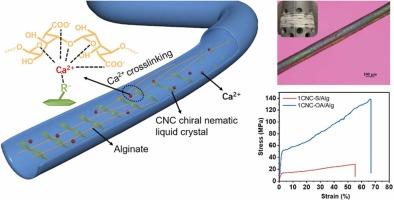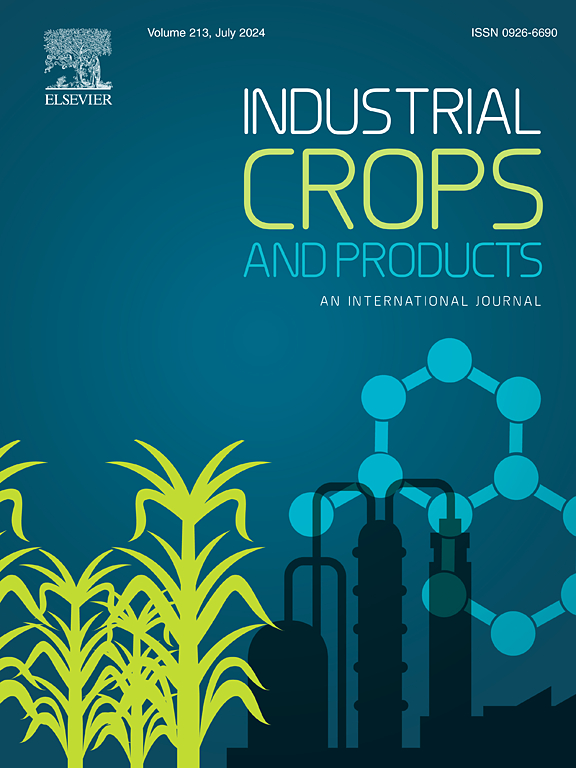用于高级可识别纺织品的多尺度分层长丝的构建
IF 5.6
1区 农林科学
Q1 AGRICULTURAL ENGINEERING
引用次数: 0
摘要
纳米粒子的有序排列所产生的结构色彩引起了人们的极大兴趣。纤维素纳米晶体(CNC)是一种液晶形式,能够随着浓度的增加自组装成胆固醇构型。CNC 的独特形态和表面功能可产生多种自组装结构。然而,要制造出既能表现出长程有序结构,又能保持可加工机械特性的连续纤维材料,仍然是一项挑战。在本文中,通过注射泵将前体纺丝溶液注入微管,并以调节的流速将其引入含有 Ca²⁺ 离子的凝固浴中,从而形成由 CNC 和海藻酸组成的多尺度细丝。实验评估和计算建模表明,草酸衍生的氯化萘和钙离子之间的交联相互作用得到了增强,从而显著改善了所制长丝的拉伸性能,最大拉伸强度达到约 140 兆帕。丝状物的创新拓扑结构赋予了它们可协调性和基于极化的加密能力,使它们成为有望用于定向信号传输或识别的先进纺织品应用的候选材料。本文章由计算机程序翻译,如有差异,请以英文原文为准。

Construction of a multi-scale hierarchical filament for advanced identifiable textile
The structural coloration arising from the orderly arrangement of nanoparticles has garnered significant interest. Cellulose nanocrystals (CNCs) represent a form of liquid crystal capable of self-assembling into cholesteric configurations as their concentration increases. The distinct morphology and surface functionalities of CNCs give rise to diverse self-assembly architectures. Nonetheless, the challenge persists in fabricating successive fibrous materials that exhibit long-range ordered structures while maintaining processable mechanical characteristics. Herein, a precursor spinning solution was injected into microtubules via a syringe pump and introduced into a coagulation bath containing Ca²⁺ ions at a regulated flow rate, resulting in multi-scale filaments composed of CNC and alginate. Experimental evaluations and computational modeling reveal that enhanced cross-linking interactions between oxalic acid-derived CNCs and calcium ions significantly improve the tensile properties of the resulting filaments, achieving a maximum tensile strength of approximately 140 MPa. The innovative topological configuration of the filaments endows them with coordinability and polarization-based encryption capabilities, positioning them as promising candidates for advanced textile applications aimed at directed signal transmission or identification.
求助全文
通过发布文献求助,成功后即可免费获取论文全文。
去求助
来源期刊

Industrial Crops and Products
农林科学-农业工程
CiteScore
9.50
自引率
8.50%
发文量
1518
审稿时长
43 days
期刊介绍:
Industrial Crops and Products is an International Journal publishing academic and industrial research on industrial (defined as non-food/non-feed) crops and products. Papers concern both crop-oriented and bio-based materials from crops-oriented research, and should be of interest to an international audience, hypothesis driven, and where comparisons are made statistics performed.
 求助内容:
求助内容: 应助结果提醒方式:
应助结果提醒方式:


